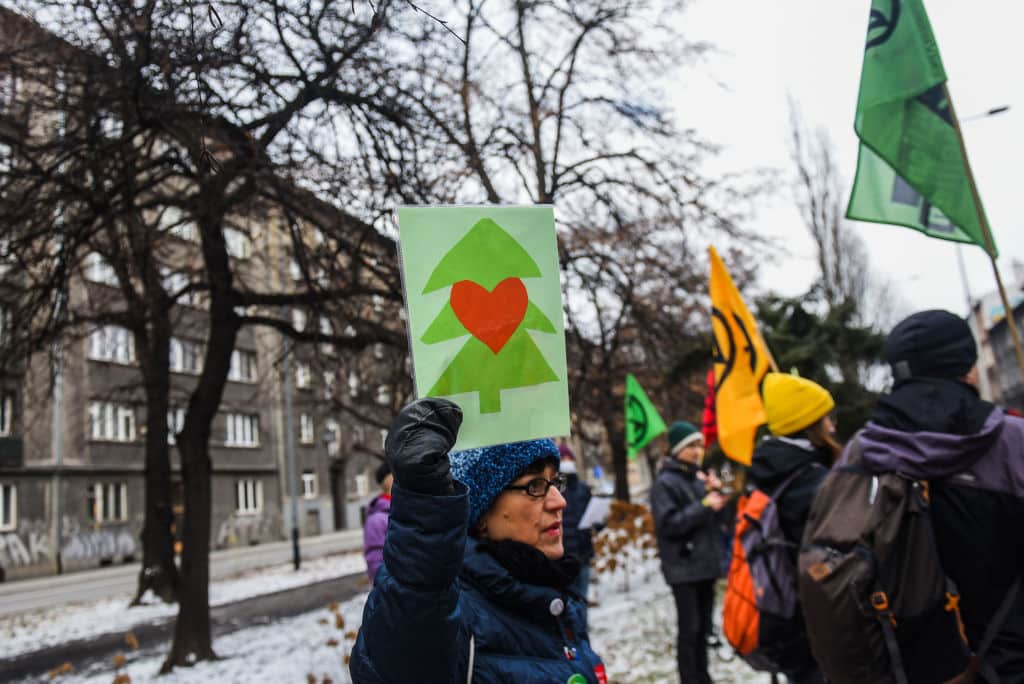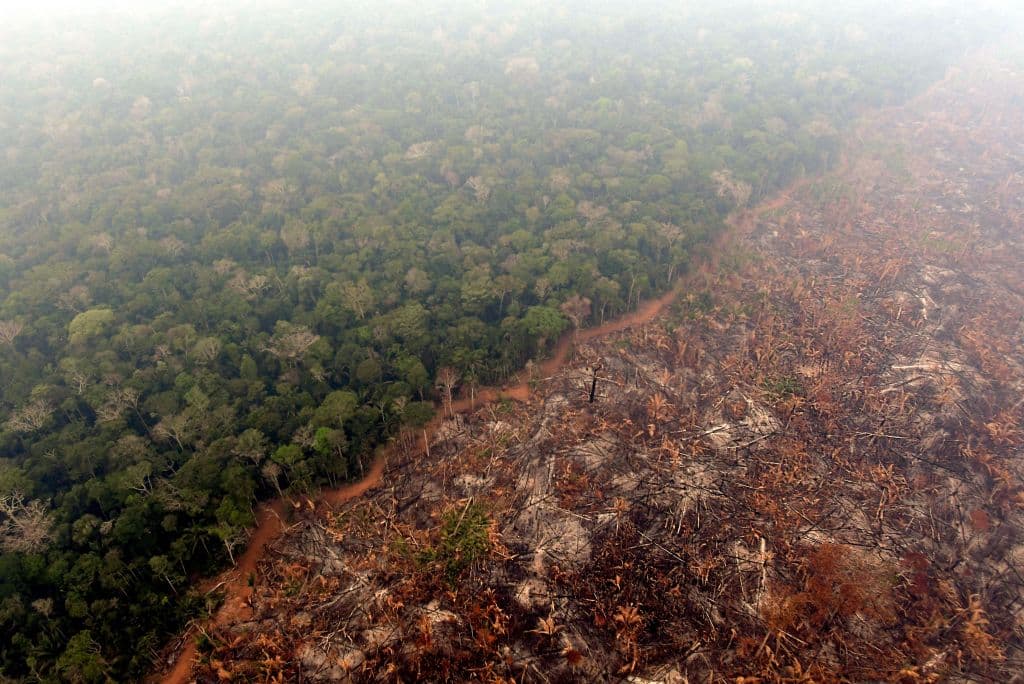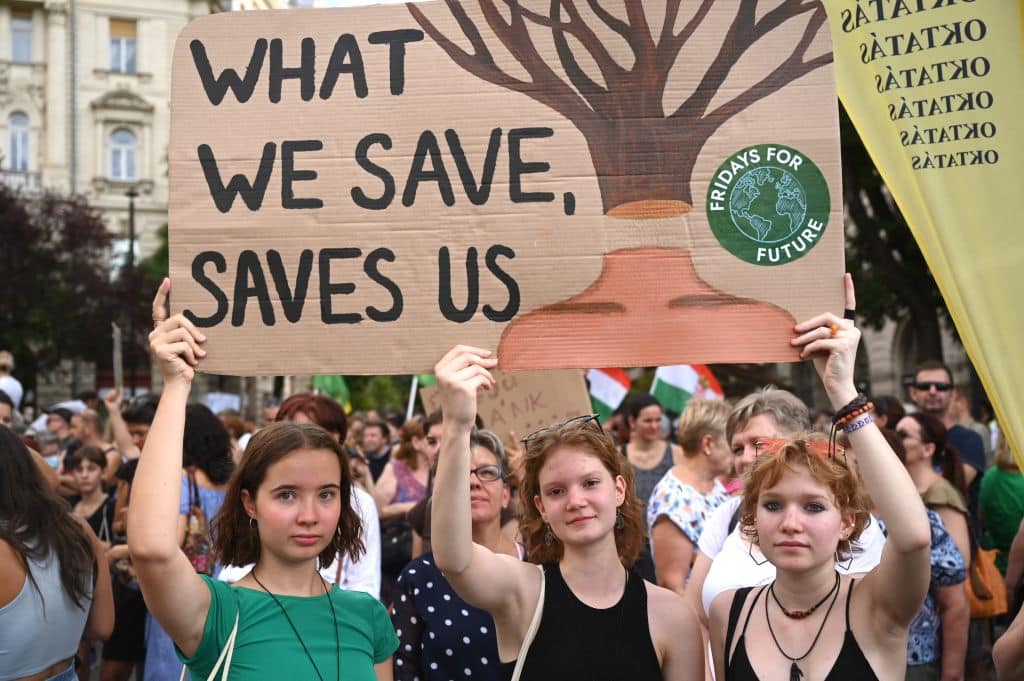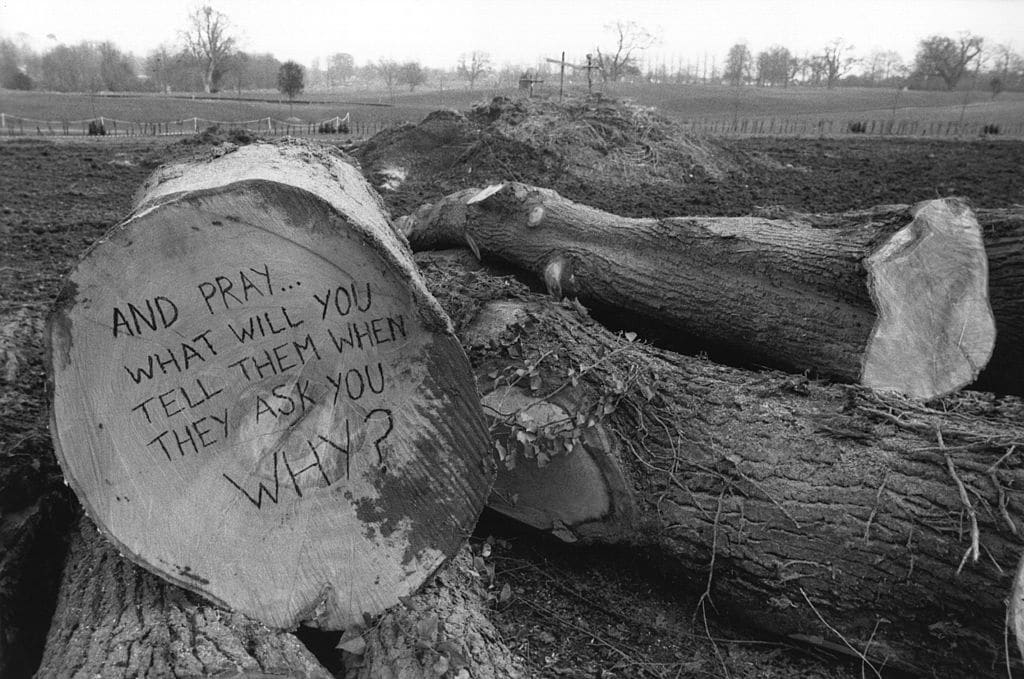Products You May Like
What is Deforestation?
Trees have been around for about 370 million years. Today, there are about three trillion trees and ten billion acres of forest on Earth. That may sound like a lot, but the planet has lost more than one billion acres of forest to deforestation since 1990.
Deforestation is the clearing of forested land with the purpose of converting it to be used for something other than forest, including the raising of livestock, agriculture, mining, development or other non-forest uses.
The biggest human causes of deforestation are farming, especially unsustainable practices such as slash-and-burn agriculture — where forests are burned and cleared for planting — raising cattle for dairy and meat and the uncontrolled cultivation of crops like rubber and palm oil.
Quick Facts
- More than 30 percent of the Earth’s land is covered by forests.
- The Earth loses about 38,610 square miles of forest every year.
- Ninety-six percent of global deforestation occurs in tropical forests.
- More than half of the planet’s tropical rainforests have been destroyed or degraded.
- Due to deforestation, as many as 28,000 species are predicted to become extinct by 2050.
- Forty-one percent of deforestation can be attributed to the clearing of land for cattle and other livestock, with 80 percent of that land located in the Amazon.
- Nearly half of tropical deforestation occurs in Indonesia and Brazil.
- Twelve percent of deforestation is due to soy production, and most soy produced globally is used for animal feed.
- Palm oil, used in products from chocolate and cookies to potato chips, is a major contributor to deforestation.
- More than 100 countries have made a commitment to end and reverse deforestation by 2030.
Why Should We Care About Deforestation?

Human Impacts
The ancient forests of our planet have been evolving for thousands of years to provide individualized habitats for millions of species of plants and animals. Millions of people also call Earth’s forests home, and their survival and livelihoods depend on them.
The livelihoods of an estimated 1.6 billion people are dependent on forests, while forests are essential for the subsistence of 60 million Indigenous Peoples.
The choices we make in what we consume, buy and support have a direct impact on the world’s forests. We can’t afford to continue to destroy such an essential part of the health of our planet.
Climate Impacts
Earth’s rainforests remove carbon dioxide from the atmosphere through photosynthesis, stabilize the Earth’s environment and act as carbon sinks by storing the carbon in their wood and soil. One of the most devastating results of deforestation is that, due to the loss of trees, the enormous amount of carbon they have sequestered gets released back into the atmosphere.
Some tropical forests now release more carbon than they capture, meaning that they no longer operate as carbon sinks.
Less trees and more carbon means faster global heating, which leads to shifting weather patterns and extreme weather, heat waves, droughts, wildfires and floods.
Palm oil and other products that contribute to deforestation, like soy and cocoa, are major contributors to the climate crisis and are causing irretrievable worldwide biodiversity loss. In order to limit global warming to below 1.5 degrees Celsius and avoid mass extinction of species and deforestation, major restoration of forests is imperative.
Biodiversity Impacts
Deforestation is a threat to the planet’s biodiversity. The loss of tropical rainforests is of particular concern because they are the most biologically diverse of the planet’s land-based ecosystems.
The largest tropical rainforest in the world, the Amazon rainforest, is home to about 427 mammal species, 1,300 species of birds, 40,000 species of plants and 2.5 million insect species. The loss of their forest home can lead to the extinction of many species.
Water and Soil Impacts
Trees help keep the balance of water in the atmosphere and on land. Deforestation can cause disruptions to this balance that can lead to shifts in river flow and precipitation.
Deforestation disrupts the natural water cycle by lowering the amount of water that comes from a process called evapotranspiration — the evaporation of water that comes from the surfaces of land, plants and their leaves. This process is crucial for the maintenance of a healthy water cycle, which is responsible for precipitation. If the cycle gets disrupted, it can lead to droughts.
Losing established forests through deforestation means losing the trees’ anchors in the soil — their roots — which are key to stopping erosion. Erosion can put surviving plants in greater danger of fire as the forest becomes drier and more open instead of moist and protected. When soil health is reduced, along with the volume of water it can contain, it increases the chance of floods.
What’s Happening and Why?

Humans have been clearing forests to make way for crops or the raising of livestock for thousands of years, and these activities are the biggest cause of deforestation. Soybean production and cattle ranching on an industrial scale have become progressively bigger contributors to deforestation in the Amazon. Tropical forests have also increasingly been converted into palm tree plantations for the commercial production of biofuels in Sumatra and Borneo.
Logging and the harvesting of wood for fuel and charcoal, as well as urbanization and the expansion of infrastructure, also contribute to deforestation.
Forest degradation is different from total deforestation, and is the progressive decline of a forested area that can be caused by a variety of reasons, including illegal logging or unpredictable weather patterns caused by climate change that can lead to pest infestations, disease and forest fires.
Accidental fires can occur after forests become degraded and more fire-prone, leading to them to eventually become deforested by recurrent unintentional fires.
Industrial Agriculture
Agriculture is the cause of nearly 90 percent of deforestation around the world and the cause of most habitat destruction. Not only is animal agriculture — including livestock and their feed — a substantial contributor to deforestation, it produces about 60 percent of the world’s greenhouse gas emissions. The food system overall makes up as much as 37 percent of human-produced emissions.
According to the 2019 United Nations’ Intergovernmental Panel on Climate Change’s Special Report on Climate Change and Land, the overhaul of the global food system and the protection and restoration of forests are essential remedies to the compounding climate, food security and biodiversity emergencies facing our society and planet.
We must slow down and stop the rampant production of products that are considered “high-risk commodities” — such as palm oil, corn and soy — that cause forest degradation, deforestation and abuses of human rights.
So far, we have been going in the wrong direction. Since 2010, palm oil production in Indonesia has increased by 75 percent, the carbon footprint of cocoa in Côte d’Ivoire has increased by 80 percent and Brazil’s agricultural area for soy production has expanded by 45 percent. If we don’t curb this trend, palm and soy production will continue to increase.
Agricultural Expansion
The expansion of the global agricultural system to meet the increasing demand for dairy and meat products and plant-based biofuels is adding to the burden on forests and escalating ecosystem destruction.
The growth of agricultural operations is the cause of almost all global deforestation, with forests cleared for animal grazing making up 40 percent.
Raising animals for consumption is extraordinarily inefficient. The production of beef as a food source requires 25 calories of feed for each calorie of beef. It takes nine calories of feed for each calorie of chicken.
Palm Oil

Palm oil — which comes from the fruits of the oil palm tree — is a main ingredient in many common products found in supermarkets worldwide, from shampoo and crackers to pie crusts and cookies.
Most of the palm oil produced in the world comes from Indonesia, where soaring demand for the product in the late 1990s led to it becoming one of the primary forces behind the country’s disappearing rainforests.
The forest clearing and slash and burn tactics that are used to make enormous plantations of the sought-after fruit have caused orangutans, koalas, birds, reptiles and other wildlife to lose their habitat and be pushed to the edge of extinction. The natural habitat of the orangutan has been almost totally decimated to make way for palm oil farms. These industrial-scale plantations also cause local rural and Indigenous Peoples to be displaced and workers to suffer human rights abuses and exploitation.
The producers and traders of palm oil — multinational corporations that profit off of the anguish and loss of others — are aware of the issues surrounding their product and have been for decades, but have not done anything to remedy them, despite assurances that they will do so.
Companies that use palm oil have also made promises to make sure nothing in their supply chain is the result of deforestation, but these assurances have also come up empty.
Cattle Ranching
In nearly every Amazon country, cattle ranching and growing soy for feed are the most significant sources of deforestation. Recently, scientists found that the Amazon rainforest, once a carbon sink, has become a carbon dioxide emitter.
Globally, 340 million tons of carbon — 3.4 percent of the world’s greenhouse gas emissions — are released annually as a result of deforestation to make way for cattle ranching, mostly in the Amazon.
Commercial Logging
While deforestation is the total elimination of the forest, along with the habitat and ecosystems it supports, logging is the cutting down of trees to make commercial goods.
The logging industry itself is not sustainable in the long-term as it makes millions of dollars by destroying forests to meet people’s insatiable need for paper products, inexpensive lumber for building homes and furniture and for use as domestic fuel and charcoal. Paper towels alone are responsible for the equivalent of around 27 soccer fields of trees being destroyed every minute.
Some day, logging may become less prevalent as new eco-friendly and sustainable building materials are developed — like bamboo, recycled bottles, mud, mushroom-based Myco-board, recycled steel, prefabricated concrete, reclaimed wood and insulation foam made of hemp, kelp or bamboo — but for now, logging is a seemingly necessary evil of modern society and a major contributor to global deforestation.
Some logging companies comply with governmental regulations for the number of trees they are permitted to cut down, but they are few and far between. Reckless logging companies demolish trees as they bore their way into forests to get at as many of the highest-value trees as possible that will bring in the highest profit.
The trucks used to fell and transport trees also contribute to soil erosion and lower soil quality.
In addition to the billions of trees lost each year to logging, the destructive practice is the cause of 60 percent of forest degradation.
Illegal Logging

What forests remain are being devastated by illegal land clearing and logging. The resulting deforestation, biodiversity loss and release of greenhouse gasses — not to mention the loss of the mitigation of emissions that forests provide — generate disputes with local and Indigenous communities that can lead to crime, violence and human exploitation.
Rates for illegal logging in timber producing nations range from 50 percent in Cameroon between 1999 and 2004 to around 60 to 80 percent in the Brazilian Amazon and an estimated 90 percent in Indonesia.
International security can be threatened when profits from illegal logging are used to finance money laundering, organized crime and civil wars. Legal timber operations are impeded by illegal ones that can undersell them and cause them to be less competitive.
It is estimated that timber-producing countries lose between $10 and $15 billion per year to illegal logging, more than one-tenth of the entire worldwide timber trade.
Illegal logging can be the result of corruption and other government failings in the countries where timber is produced. And when countries that purchase the timber — like the U.S., Japan and EU member states — fail to ban the import of timber that is illegally or irresponsibly cut down, it can lead to the continued exploitation of ancient forests by timber companies and traders.
The EU does not have any import bans on illegal timber. The development of laws that could incorporate a ban have been recommended by the EU’s Forest Law Enforcement, Governance and Trade project, but for the time being only voluntary action has been encouraged by the European Commission, which is not sufficient or realistic to protect our forests.
Infrastructure Expansion
Deforestation is also caused by the use of slash and burn techniques and other methods to make way for the expansion of infrastructure. Infrastructure expansion occurs for many reasons, such as when urban sprawl leads to forests being encroached upon by cities; when people flee urban areas in order to build in more rural, forested settings; to make way for mining operations; and for the expansion of farmland.
Mining
As the demand for energy derived from renewable sources increases, Earth’s forests are in greater danger, since many of the minerals required for wind turbines, solar panels and battery storage are mined in vulnerable forested areas like the Congo Basin. The dichotomy between the need for minerals to produce renewable energy in order to reduce carbon dioxide emissions and the destruction of forests through mining for them is a major cause for concern and presents a new set of challenges that has yet to be resolved.
In the next three decades, worldwide demand for minerals like graphite and cobalt is expected to soar to five times the current rate.
Climate Change and Deforestation
Deforestation is itself also a prime contributor to human-caused climate change. The release of carbon from the clearing and burning of forests contributes directly to global heating.
The three biggest tropical rainforests in the world are found in Southeast Asia, the Amazon River Basin of South America and the Congo. In the past two decades, Southeast Asian forests have become a net source of carbon due to peat soil drainage, the clearing of forests for plantations and rampant fires.
Parts of South America’s Amazon River basin are now a source of carbon rather than a net carbon sink. Deforestation in this region has intensified in recent years because of degradation from forest fires, land clearing to make way for cattle and increasing temperatures that lead to drier conditions.
The tropical rainforest in the Congo is the only one of the world’s big three tropical rainforests that can still be considered a strong net carbon sink. It sequesters more than 600 million tons more carbon annually than it releases, equal to about a third of the carbon dioxide emissions from all transportation in the U.S.
Where Are the Main Places Deforestation Is Happening Around the World?

One of the main places is South America, where farm animal grazing accounts for 75 percent of deforestation. In Brazil, deforestation has increased despite 1.5 million square miles of the Amazon rainforest being protected. The government weakened the environmental protections in 2018, and since then deforestation caused by logging, industrial agriculture and other industries has increased.
Nigeria, Honduras and the Philippines are also experiencing some of the most severe deforestation on the planet. From 2001 to 2021, Nigeria lost 2.82 million acres of tree cover and has lost more than 90 percent of its forests. Between 1990 and 2005, forests in Honduras declined by 37 percent, and the Philippines now only has 35 percent of its former tree cover.
How Can We Combat Deforestation?

As a Society
One of the strategies to turn the tide on deforestation is to implement different types of policy solutions, such as:
- Reducing profits from agricultural methods that contribute to deforestation
- Establishing protected areas
- Expanding protective forest strategies like changing the ownership and management of forests
In Our Own Lives
Some ways we can reduce our own forest footprints include:
- Reducing our need for wood-based goods
- Using less paper
- Using less energy
- Purchasing secondhand furniture
- Buying forest friendly goods, like certified wood products
- Demanding better certified and sustainable labeling of wood products
- Buying wood-based products that have been recycled and recycling them again
- Supporting companies that are dedicated to reducing deforestation
- Reducing or eliminating our consumption of meat, dairy, palm oil, coffee, cocoa, soy and sugar, all of which contribute to deforestation
- Recycling paper, cardboard and other wood-based products
- Encouraging local governments to protect forests and oppose urban sprawl
- Supporting forest friendly NGOs
- Volunteering with a local parks department or land trust
- Considering a conservation easement for privately owned, forested land
- Advocating for climate change solutions
- Spending time in forests and sharing our love of forests with others
- Helping to educate our communities
Going vegan is another great way to reduce your forest footprint. Since almost 90 percent of deforestation is caused by the clearing of land for animal grazing and agriculture — much of which is crops grown for animal feed — when you reduce or eliminate your intake of animal products, including dairy, you substantially reduce how much your diet contributes to deforestation.

Takeaway
Deforestation is robbing the world of much of its rich biodiversity and contributing to global warming. If the current rate of deforestation continues, just 10 percent of rainforests will remain by 2030. And if the trend carries on beyond that, all the rainforests on Earth will be gone within a century, causing untold cataclysmic effects on the climate and wiping out most plant and animal species.
Our daily choices and those of other consumers, policymakers and landowners around the world can help turn the tide from destruction to replenishment.
